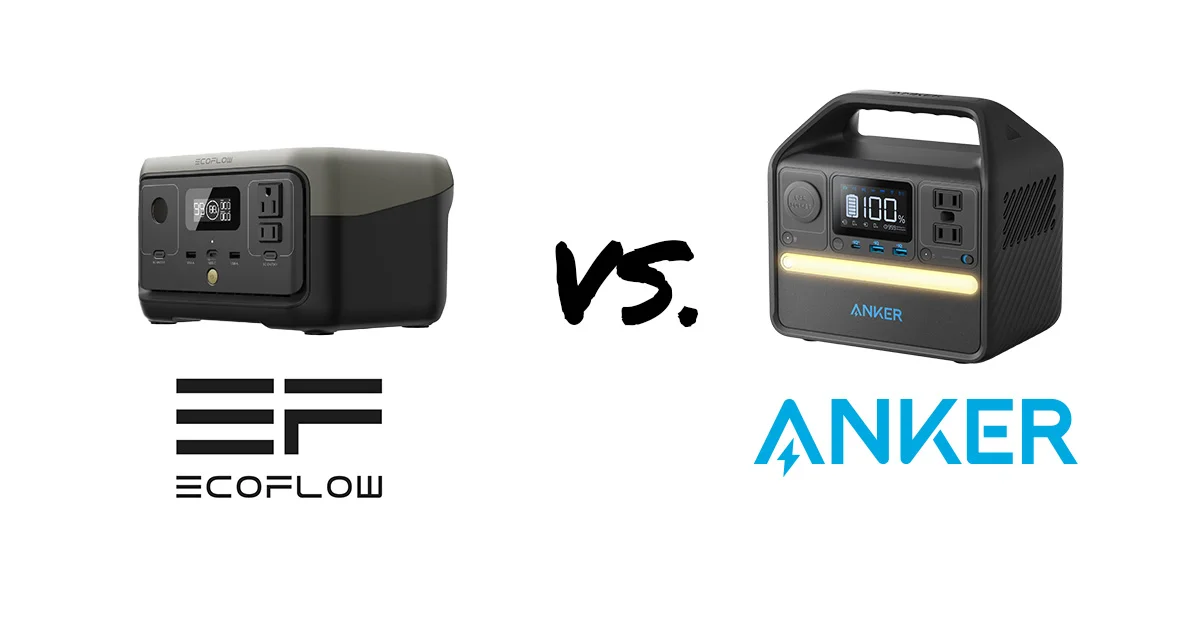In the land of small power stations, it’s easy to get lost in the shuffle. If you’re comparing the EcoFlow River 2 vs. Anker 521, it’s time to get the real information you need. This guide filters out the wild marketing claims and cuts down to the real deal.
The truth is that both EcoFlow and Anker power stations are high quality. And the specs of the EcoFlow River 2 compared to the Anker PowerHouse 521 are more similar than just about any two power stations around. Yet there is one that comes out ahead. And some features only available in one of these small power stations might be vital to your use.
In this short guide, we’ll walk you through this comparison between the EcoFlow River 2 and the Anker PowerHouse 521 to show you where the real differences are hiding in plain sight.
We carefully select the products and services we link to. If you buy through our links, we may earn a commission. There’s no extra cost to you and it helps us provide this information.
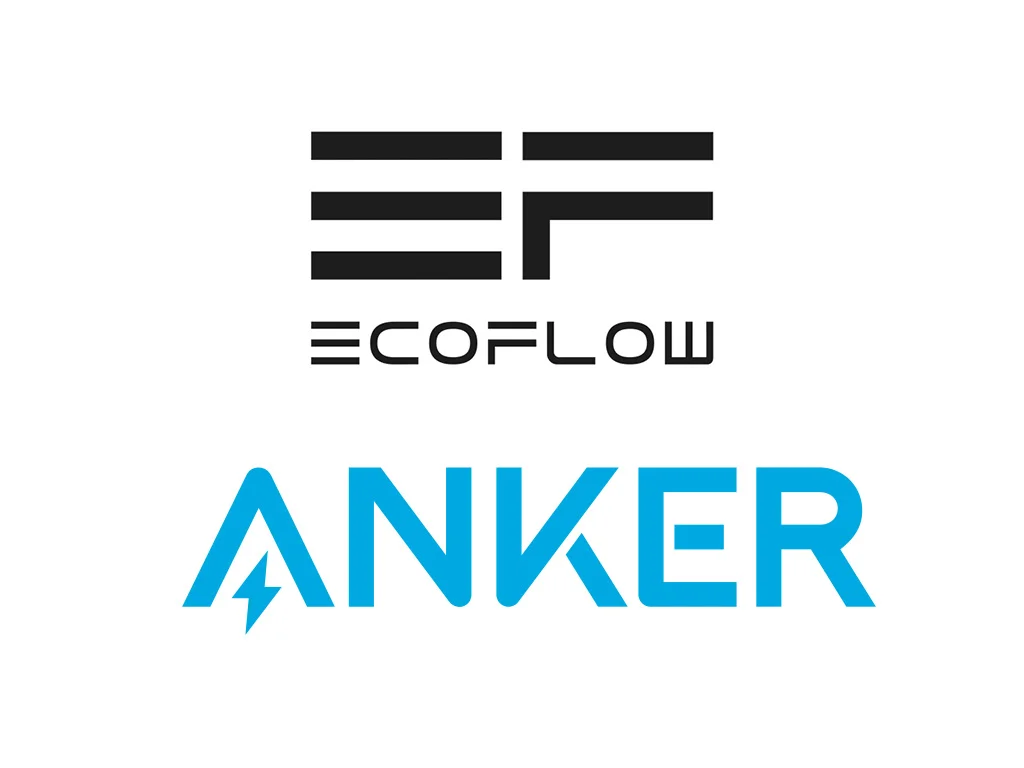
The Quick Summary
Let’s start off with the honest truth: These are remarkably similar power stations. With the exception of a few features, many people would basically never know a difference between the two.
Here’s a list of things that both of these small power stations have in common:
- 256Wh LiFePO4 battery with >3,000 cycles at 80% or more
- 2 AC outlets, 2 USB-A ports, 1 USB-C port, and 1 car cigarette port
- Superb manufacturing quality backed with 5 year warranty
As you can see, the EcoFlow River 2 vs. Anker 521 comparison is an insanely close battle. Both brands have a superb reputation. And these power stations might be small, but they have all the right components. The best battery chemistry, enough ports to keep a handful of devices running, and a lengthy warranty coverage that provides a lot of peace of mind.
Yet, if you take a closer look, there are some critical differences lurking in the shadows. In fact, there’s really no sugar coating it. The EcoFlow River 2 comes out ahead of the Anker PowerHouse 521.
The EcoFlow River 2 features that are beyond the Anker 521’s include:
- More powerful AC inverter (300W with 600W peak vs. Anker’s 200W always)
- Much faster recharging rates (1 hour recharge vs. Anker’s >4 hours)
- EPS function to have nonstop power (EcoFlow 30ms EPS vs. some Anker ports you can’t use while charging)
These differences push the EcoFlow River 2 ahead of the Anker PowerHouse 521. The AC inverter means you can run more devices through the AC outlets. And the recharging rate of the EcoFlow is seriously fast, getting rid of all charging anxiety.
But the EPS function of the River 2 compared to the Anker 521 shutting down certain ports while charging might be the most important difference. And it’s made even worse by Anker’s long charge time.
Overall, we still stand behind both of these as highly-recommended power stations for those that need an affordable and compact portable power source. They both can serve well as a small camping solar generator or a way to add a small amount of solar power to an RV.
But when push comes to shove, the EcoFlow River 2 will be the better choice.
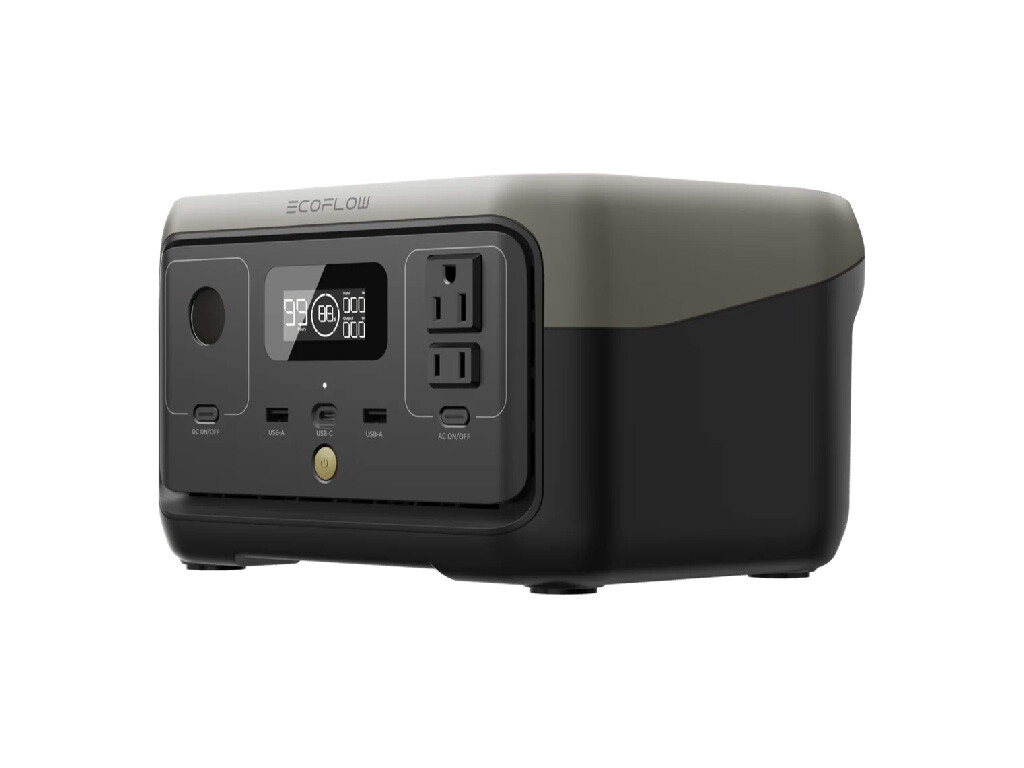
|
EcoFlow RIVER 2 |
R2 on EcoFlow Buy on Amazon |

|
Anker 521 PowerHouse 256Wh Portable Power Station |
Buy on Anker Buy on Amazon |
| Product | EcoFlow RIVER 2 | Anker Powerhouse 521 |
|---|---|---|
| Battery | 256Wh | 256Wh |
| AC Output | 300W | 200W |
| AC Input | 360W | 65W |
| Solar Input | 110W | 65W |
| Warranty | 5 years | 5 years |
| Buy Now | Buy R2 | Buy Now |
| Buy on Amazon | Buy on Amazon | Buy on Amazon |

Battery Capacity
If there’s one feature that’s more important than any other, it’s the battery of the power station. And when it comes to the best off-grid batteries, there are two things to keep an eye on:
- Battery capacity
- Battery chemistry
Battery capacity is usually rated in Watt-hours (Wh). And in the case of the EcoFlow River 2 vs. Anker PowerHouse 521 battery capacity, they’re tied at 256Wh. The exact same.
But what does that 256Wh actually mean? It’s a pretty simple thing to figure out.
Let’s say you have a device that takes 10W to run. This is the amount of energy it constantly uses. If you run the small 10W device for 1 hour, you’ll use 10Wh of energy. 10W x 1h = 10Wh. You can calculate how long the River 2 or Anker 521 battery will last by:
- Figure out how much watts your devices will use at one time.
- Take the 256Wh battery capacity and divide by the amount of watts you want to use consistently
- The result is the estimated number of hours the power station will last
- Take off about 20% because every power station has expected inefficiencies and power loss due to thinks like heat, connections, and the AC inverter (when used)
Many small portable devices are about this level of power. One LED light usually takes 10W. Many cell phone batteries are about 10-12Wh. But other devices can use more power. A small 12V fridge might run at about 60W, which is 60Wh in one hour, 120Wh in two hours, etc. Laptop batteries can be around 60Wh or more.
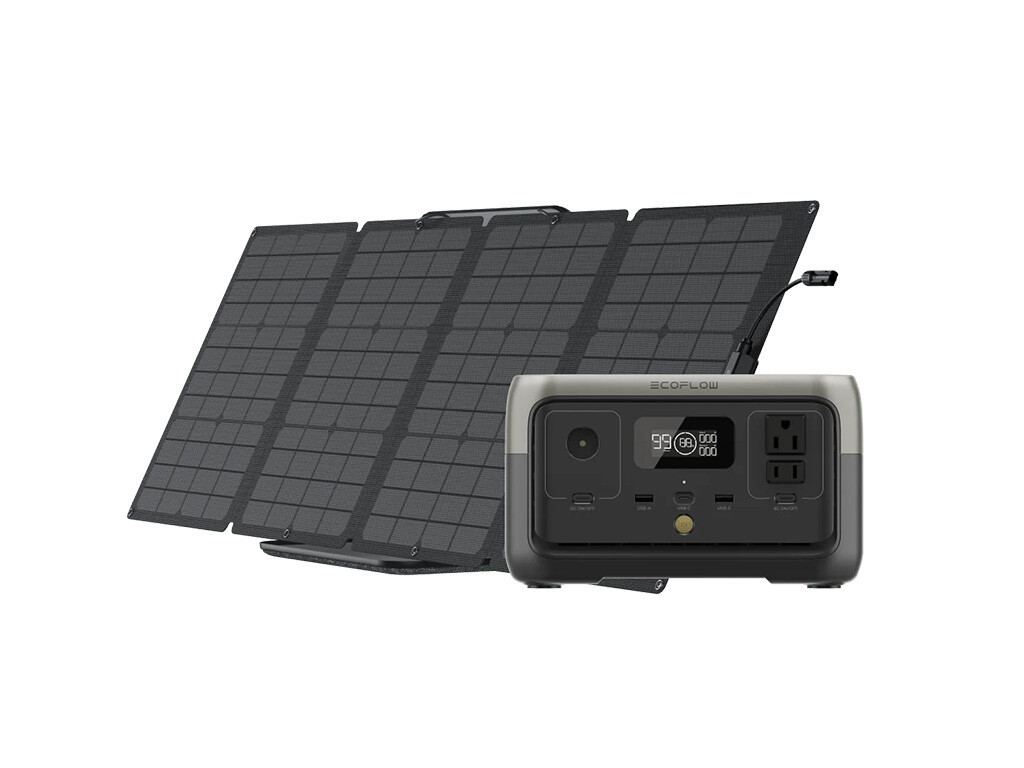
These are great devices to keep your phone charged while camping.
With this 256Wh battery that’s the same in this EcoFlow vs. Anker 521 battle, you can charge a phone about 20 times or run an LED light for >20 hours. But if you try to power larger devices, that runtime goes down sharply. Using 100W worth of energy will run down the battery in less than 3 hours. The battery makes it possible to use solar power at night.
The other concern with batteries is the chemistry they’re made of. You might be familiar with lithium batteries. But did you know there are different types of lithium ion batteries? And that these different types impact how long you can expect the device to be useful for?
Lithium iron phosphate (LiFePO4 or LFP) is the power station gold standard. It’s a long-lasting battery that can keep about 80% of its rated capacity for up to 10 years or around 3,000 cycles. A cycle is when the device goes from fully charged to depleted.
Both of these power stations use LiFePO4 battery chemistry with a rated 3,000 cycles at 80% or more capacity. They’re truly as good as it gets right now. Most brands stick to this type, but some of the older Jackery power stations still use NMC lithium-ion, rather for 1,000 cycles or less. Not EcoFlow or Anker though.
Battery Verdict: Both of these power stations have 256Wh battery capacity using LiFePO4 battery chemistry. It’s a dead even tie. They’re both ready to power small devices and will last many years. But neither one is suitable for big energy needs because the battery is fairly small.
| Product | EcoFlow RIVER 2 | Anker Powerhouse 521 |
|---|---|---|
| Battery | 256Wh | 256Wh |
| Warranty | 5 years | 5 years |
| Battery Type | LiFePO4 / LFP | LiFePO4 / LFP |
| Battery Cycles | >3,000 | >3,000 |
| Buy Now | Buy R2 | Buy Now |

AC Inverter Output
Next up is the AC output from the AC inverter. In plain language, it’s how much power comes out of the regular household outlet. The higher the watts, the more powerful devices you can use through the AC outlet.
Both of these have very small AC inverters. And that’s ok. Why’s that? It’s because:
- With a small battery, it makes sense to keep the inverter size down too.
- Two AC outlets can’t power a ton of high-powered devices
- Everything for these power stations is expected from this price level and compact size
The power is limited so you’re not going to run a huge lineup of AC devices off of either power station.
Let’s start with the less powerful Anker 521. Even though the battery size is the same, the AC output is lower in the Anker 521. It is rated at 200W. Which means it can run devices through the AC plug that are 200W or less. So if you try to connect a 1,000W microwave, it won’t have power. The same if you try to connect a hair dryer or a powerful blender. There’s not enough power coming out of the outlet.
But 200W can be very useful. WiFi routers are usually less than 100W. Small portable fridges can be less than 200W. There’s a long list. And the Anker 521 will handle those.
The EcoFlow River 2 does a little better though.
Not only does the River 2 offer a 300W inverter (an extra 100W), it also has a peak output that doubles to 600W. This is important because many devices need a big surge of power to get started. The Anker tops out at 200W. The EcoFlow can run 300W continuously and will match 600W surges if needed.
Inverter Verdict: The EcoFlow River 2 has a more powerful inverter with 300W continuous and 600W peak power. The Anker PowerHouse 521 has a 200W AC inverter output. They both have 2 outlets and are best for low-powered devices only.
| Product | EcoFlow RIVER 2 | Anker Powerhouse 521 |
|---|---|---|
| AC Output | 300W | 200W |
| AC Output Peak | 600W | 200W |
| 120V Outlets | 2 | 2×1.82A |
| UPS / EPS | 30 ms (EPS) | – |
| Buy Now | Buy R2 | Buy Now |
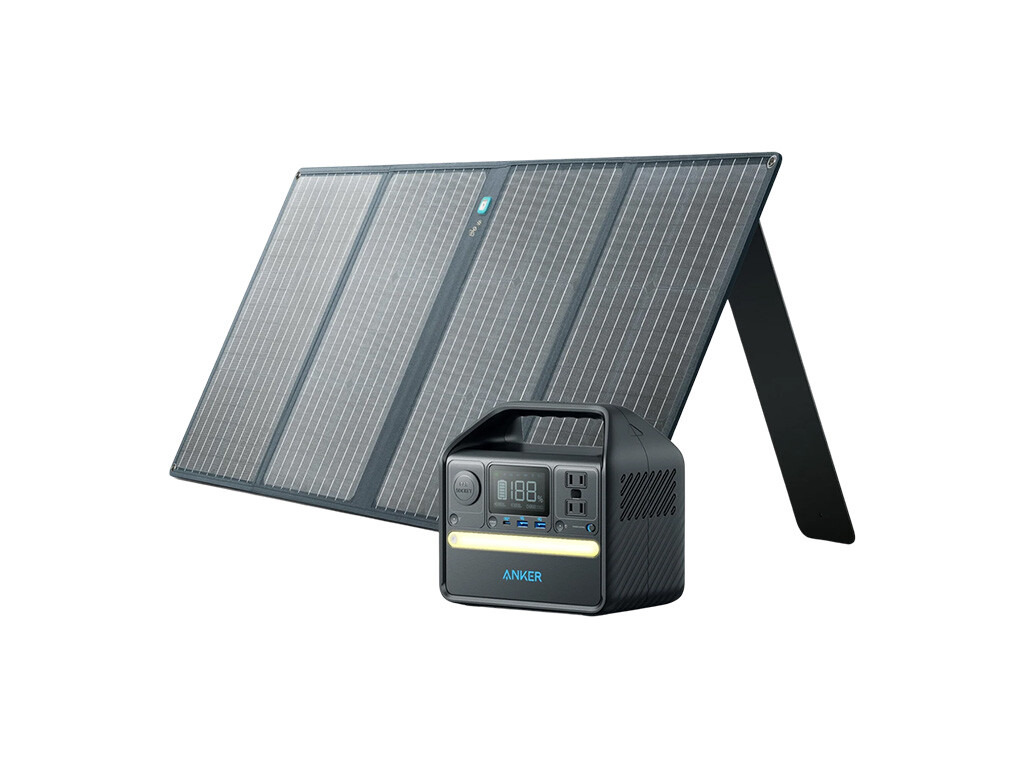
Charging Rates
A power station without power is useless. And that’s why the recharging rates are another important feature to understand. This includes the rates to charge from a standard AC wall outlet as well as the charging rates from off-grid sources like solar panels and even car charging.
Here is where the EcoFlow starts to really peel away from the Anker. EcoFlow has exceptionally fast recharging rates, especially considering the battery size. It can fully recharge in an hour on a wall outlet or about 2-3 hours of solar.
Anker’s is still fairly respectable but it caps out at 65W, and for a 256Wh battery to recharge at 65W, it will take at least 4 hours.
The EcoFlow’s solar input can accept up to 110W. If you get your hands on one 100W panel, you’ll have a nice time recharging this entire power station in one sunny day, likely with hours of sunlight to spare. It’ll be as easy as it could be. You don’t even need the 800W Alternator Charger for this little power station. The car’s cigarette lighter port can do the 100W charging as well.
Anker’s 65W solar input limit means that you’ll need probably well over 5 hours of peak sunlight to go from 0% to 100%. That is hard to get in one day in many areas. Thankfully, you probably can still use a 100W panel because Anker did allow for a pretty high voltage. But the lower current means 65W max charging. It’s not the end of the world, but it will be more annoying if you’re using a lot of the battery each day.
Head over to these articles to learn a little more about solar panels:
For household outlets, you can charge the EcoFlow while you’re packing and still drive away with a full battery. Plug it in when it starts to rain, and it’ll probably be full before the first lightning strike has a chance to take out your power. The Anker needs a handful of hours. Not terribly tragic, but simply not as impressive as the EcoFlow.
Charging verdict: The Anker 521 can recharge in less than 6 hours from most sources, which is not bad. But the EcoFlow River 2 has an incredibly fast charging rate that can fill the entire battery in about an hour from an outlet or 2-3 hours from solar. EcoFlow is the charging champion.

|
EcoFlow RIVER 2 |
R2 on EcoFlow Buy on Amazon |

|
EcoFlow RIVER 2 Solar Generator with 110W Portable Panel |
Buy on EcoFlow Buy on Amazon |

|
Anker 521 PowerHouse 256Wh Portable Power Station |
Buy on Anker Buy on Amazon |

|
Anker 521 Solar Generator + 100W Solar Panel |
Buy on Anker Buy on Amazon |
| Product | EcoFlow RIVER 2 | Anker Powerhouse 521 |
|---|---|---|
| AC Input | 360W | 65W |
| Solar Input | 110W | 65W |
| Solar Input 1 Volts Min | 11V | 11V |
| Solar Input 1 Volts Max | 30V | 28V |
| Solar Input 1 Amps | 8A | 5.5A |
| Buy Now | Buy R2 | Buy Now |
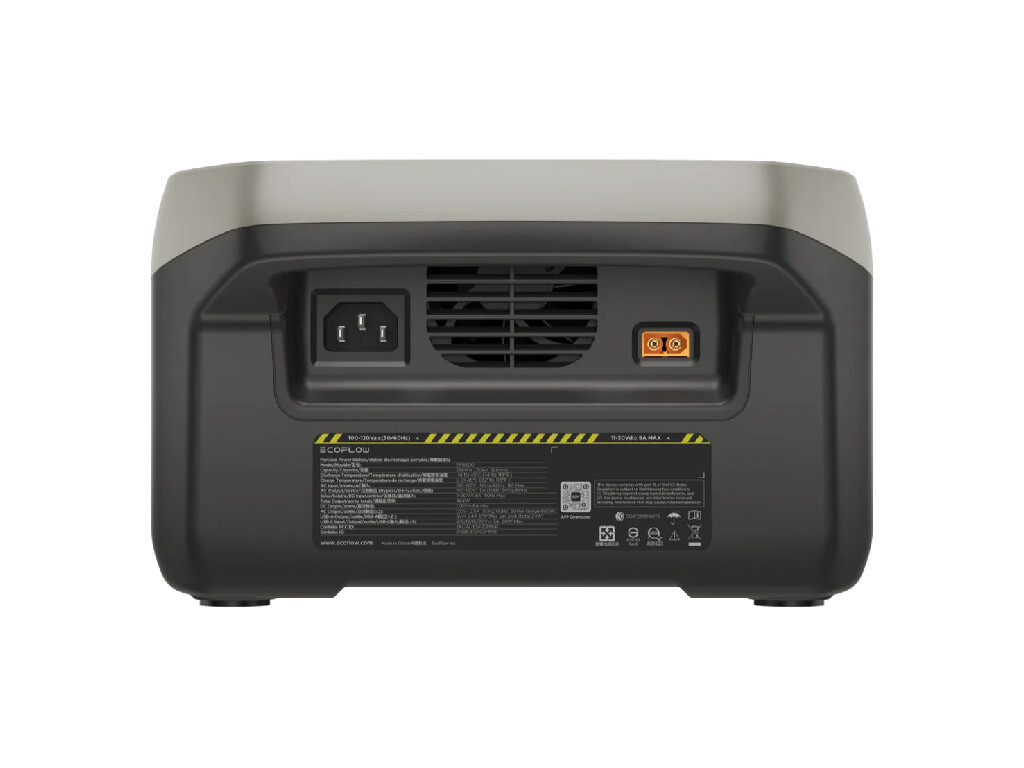
Using While Charging
There’s one undeniable difference that’s a little hard to understand. Power stations are more complicated than they look, packed with input chargers, battery management systems, and intricate components to absorb energy and deliver it to your devices.
And one way this complexity comes out is when you try to use a power station while it’s charging.
The Anker 521 falls even further behind due to this. While charging the internal battery of the Anker 521, you cannot use the AC outlet. Yes, you read that right. You must choose between charging the power station or charging your devices off of the AC outlet. You can still use the USB ports, but not the AC outlet. There is no pass-through charging.
When you factor in the slow recharging rate of the Anker and this fact you can’t use the AC outlet while it’s charging, there can be many hours each day where your devices are left without power.
EcoFlow takes an entirely different approach. One that’s honestly well above this price range. It includes a pass-through powering system so you can use it while it’s charging.
The EcoFlow River 2 offers a function called emergency power supply (EPS). This means that it is designed to be plugged into the wall while it is also powering a device. If the wall power fails like during a storm, the EcoFlow will switch over to battery and keep powering your connected devices.
This means you can not only use the EcoFlow while it’s charging, but you can leverage it to make sure your most important devices never lose power.
Now, there is a catch. This function is usually called a uninterruptible power supply (UPS). The reason why EcoFlow uses the term “EPS” instead of “UPS” is because it takes a little longer to switchover. The River 2 EPS will switch from AC grid power to internal battery power in 30ms or less. It’s about the speed of blinking an eye.
The problem is that some devices will notice this 30ms drop in power and might need to restart. Other true UPS devices (which are usually MUCH more expensive) will switch quicker, downward to 10ms or even 0ms (constant).
The basic rundown is:
- 0ms is the best UPS around, constantly delivering power from the grid or battery as needed. This is what large data centers and other absolutely critical devices use. This is not reasonable for this level of power station. You can find this on the best solar generator for home backup, the EcoFlow Delta Pro Ultra.
- 10ms is a high-quality UPS, switching from grid to battery in 10ms or less, which can keep many devices running, including computers. Not a good idea for a large data center, but very good for home use. Some high-quality mid-range power stations have this fast of switchover, but not small affordable ones. The Delta Pro 3 is one.
- 20ms to 30ms is still a great switchover time but generally is called an EPS instead of UPS due to the longer switchover time. Many devices will notice the power interruption and will quickly reboot. Some computers and televisions might retain enough power to get through the switchover without rebooting.
Nonetheless, the EcoFlow’s EPS function and just the fact you can use it while it’s charging make it one of the best small power stations you can find.
Use While Charging Verdict: The EcoFlow River 2 is much better than the Anker 521 in this category. You can use the EcoFlow while it charges, and it will even automatically switch to battery power within 30ms using its EPS function. The Anker AC outlet cannot be used while you’re charging the 521’s internal battery. Pass-through charging is not supported.
| Product | EcoFlow RIVER 2 | Anker Powerhouse 521 |
|---|---|---|
| 120V Outlets | 2 | 2×1.82A |
| UPS / EPS | 30 ms (EPS) | – |
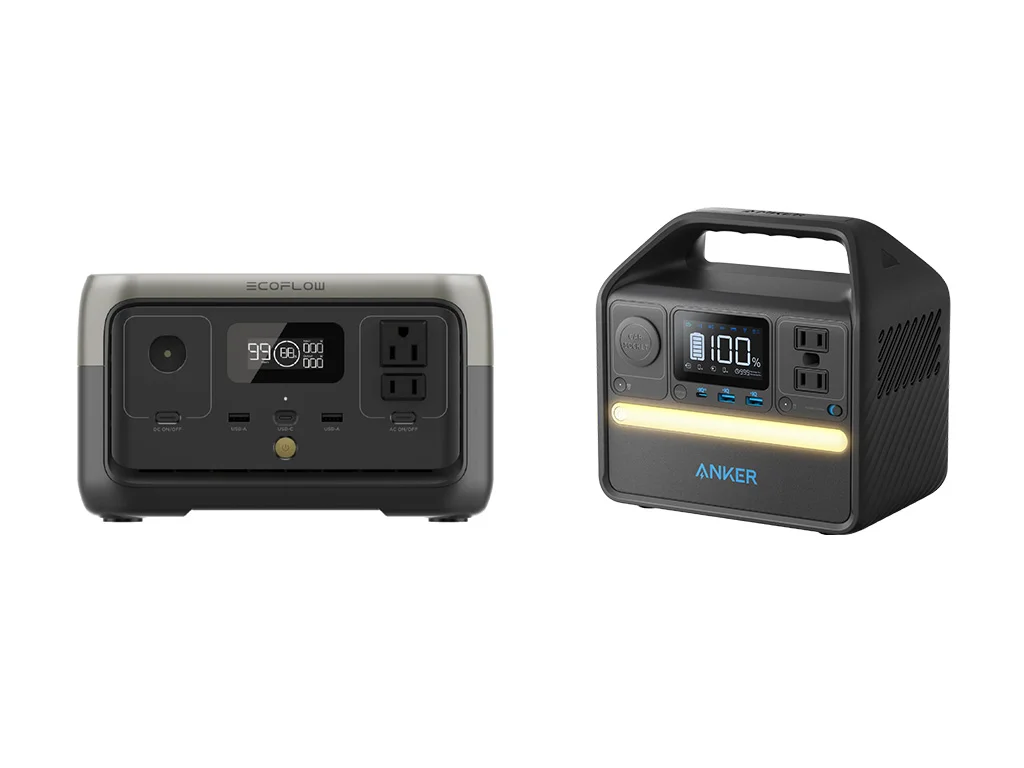
Ports and Outlets
Let’s stay on the general idea of power outlets for these power stations. It’s important to understand how many ports and outlets they have to make sure you can run the devices you want to keep charged up.
While not directly related to ports, the Anker does have a large light across the front. That might be a pretty useful thing to have around.
Both the River 2 and the PowerHouse 521 have identical ports and outlets, including:
- 2 AC outlets
- 2 USB-A ports
- 1 USB-C port
- 1 car cigarette port
The three different USB ports are likely going to be the most useful for these small power stations. These avoid the waste created by the AC inverter’s outlets and many small devices can charge or run directly off the DC USB output.
The car cigarette lighter port is also a nice touch to have. It’s actually the most powerful DC port on both power stations, with 100W on the EcoFlow and 120W on the Anker. Yes, the Anker is slightly more powerful! But since the battery is 256Wh, maxing out either of these ports will chew through the battery very quickly.
The only downside to both of these compared to other power stations is that they lack app connectivity and a wireless charging pad. There are some smaller Bluetti power stations that have both of these features.
Ports and Outlets Verdict: in the EcoFlow River 2 vs. Anker 5321 comparison, the ports and outlets are identical. Both have 3 USB ports, 2 AC outlets, and 1 cigarette lighter port. The AC outlets are more powerful for the EcoFlow, while the Anker’s cigarette port is slightly more powerful.
| Product | EcoFlow RIVER 2 | Anker Powerhouse 521 |
|---|---|---|
| 120V Outlets | 2 | 2×1.82A |
| USB-A Ports | 2 x 12W | 2 x 12W |
| USB-C Ports | 1 x 60W | 1 x 60W |
| Cigarette Lighter | 1 x 100W | 1x 120W |
| Wireless Charging Pad | – | – |
| Connectivity | – | – |
| Buy Now | Buy R2 | Buy Now |

Warranty and Customer Support
When you’re spending hard-earned cash, you should get a high-quality product in return. And the company should stand behind its design with a warranty that covers the useful life of the product, with a customer support staff that’s there to answer the questions you have.
We do a lot of work to create these guides, and after careful investigation into both EcoFlow and Anker, we can highly recommend both of these companies.
And when it comes to the specific warranty for the EcoFlow River 2 and Anker PowerHouse 521 power stations, they both have an amazing 5-year warranty period. The battery will likely last ten years or more with an adequate charge, but a 5-year warranty coverage is an amazing amount of coverage. It’s like putting a 100,000 mile (~160,000 km) warranty on a car. You won’t find anything better, except for a very limited amount of Bluetti home backup power stations that come with a whopping 10 year warranty.
But they both go far beyond that. Both have detailed user manuals, full customer support to answer questions before your purchase it or while you’re using it. And they’ll even help you troubleshoot problems. Or just simply help you return and replace it if a problem is manufacturing related.
Warranty Verdict: The warranty for the EcoFlow River 2 and Anker 521 is tied with an industry-best 5 year warranty period. And both companies are well-known for high-quality craftsmanship and excellent customer support.
| Product | EcoFlow RIVER 2 | Anker Powerhouse 521 |
|---|---|---|
| Warranty | 5 years | 5 years |
Weight & Dimensions
You can’t deny that both of these portable power stations are some of the lightest and smallest around. While you can find smaller ones, like the Jackery 100 Plus and it’s TSA-approved battery size, they often lack the AC outlet or other features.
These are both less than 10lbs (~4kg) and are about the size of a shoebox. They really put the “portable” in the power station name.
The biggest difference is that the Anker has a protruding fixed handle on top. It’s a nice feature to make carrying it easy, but it also means that things don’t stack on top of it as well. EcoFlow has a fixed handle as well, but it sticks out the backside of the power station. That gives it a nice flat surface on top.
Weight & Dimensions Verdict: Both are small and lightweight with a nice carrying handle. The EcoFlow is slightly lighter and has a flat top surface with a handle hidden on the backside. The Anker is still less than 10lbs (4kg) and has a handle on top.
| Product | EcoFlow RIVER 2 | Anker Powerhouse 521 |
|---|---|---|
| Weight (lbs) | 7.7lbs | 9.6lbs |
| Weight (kg) | 3.5kg | 4.3kg |
| Dimensions (in) | 9.6×8.5×5.7in | 8.5×8.3×5.7in |
| Dimensions (mm) | 244x216x145mm | 216x211x144mm |
| Buy Now | Buy R2 | Buy Now |
User Manuals
Here are links to the user manuals for both of these small power stations.
| Product | EcoFlow RIVER 2 | Anker Powerhouse 521 |
|---|---|---|
| User Manual | User Manual | User Manual |
Full Comparison Chart With All Specifications
Here is a large comparison chart with all of the specs for the EcoFlow River 2 and Anker 521 power stations. You can review everything from AC output to the number of ports, and even the best links to buy these from.
| Product | EcoFlow RIVER 2 | Anker Powerhouse 521 |
|---|---|---|
| Battery | 256Wh | 256Wh |
| AC Output | 300W | 200W |
| AC Output Peak | 600W | 200W |
| AC Input | 360W | 65W |
| Solar Input | 110W | 65W |
| Warranty | 5 years | 5 years |
| Weight (lbs) | 7.7lbs | 9.6lbs |
| Weight (kg) | 3.5kg | 4.3kg |
| Dimensions (in) | 9.6×8.5×5.7in | 8.5×8.3×5.7in |
| Dimensions (mm) | 244x216x145mm | 216x211x144mm |
| Solar Input 1 Watts | 110W | 65W |
| Solar Input 1 Volts Min | 11V | 11V |
| Solar Input 1 Volts Max | 30V | 28V |
| Solar Input 1 Amps | 8A | 5.5A |
| Battery Type | LiFePO4 / LFP | LiFePO4 / LFP |
| Battery Cycles | >3,000 | >3,000 |
| 120V Outlets | 2 | 2×1.82A |
| UPS / EPS | 30 ms (EPS) | – |
| USB-A Ports | 2 x 12W | 2 x 12W |
| USB-C Ports | 1 x 60W | 1 x 60W |
| Cigarette Lighter | 1 x 100W | 1x 120W |
| Wireless Charging Pad | – | – |
| Connectivity | – | – |
| User Manual | User Manual | User Manual |
| Buy Now | Buy R2 | Buy Now |
| Buy on Amazon | Buy on Amazon | Buy on Amazon |
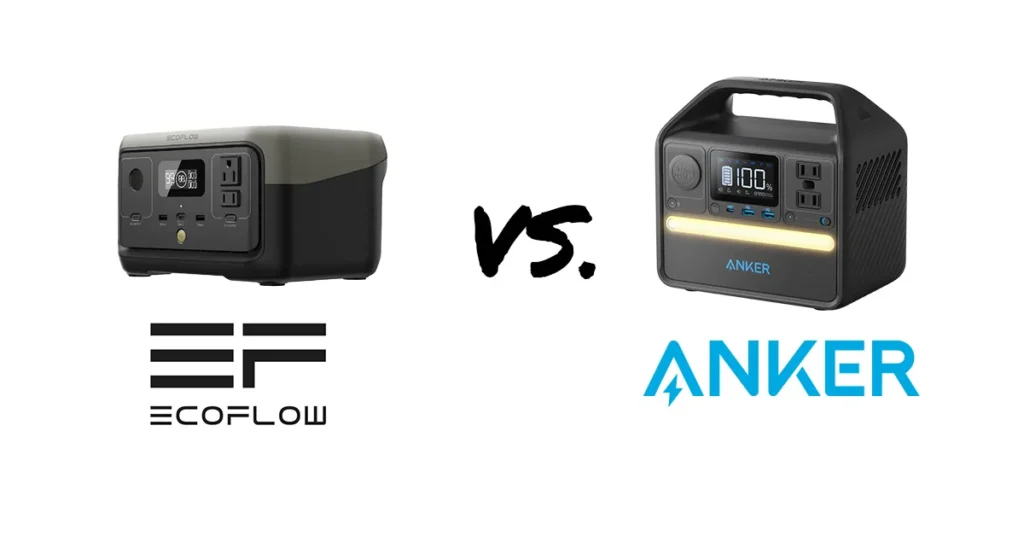
Final Verdict: EcoFlow Takes the Cake
You really can’t go wrong with either one of these power stations. They have a 256Wh battery made from the right LiFePO4 battery cells, and come from top companies with a 5 year warranty. Even the ports and outlets are all nearly identical. So is the weight and most of the other design points.
So don’t completely write off the Anker 521. It’s definitely worth it and won’t disappoint.
But the EcoFlow River 2 comes out on top because it has:
- More powerful inverter (300W with 600W peak compared to Anker’s 200W)
- Faster charging rates (360W AC charging and 110W solar charging compared to Anker’s 65W on both)
- Pass-through charging with EPS function (can charge the EcoFlow while using it and it comes with 30ms EPS switchover when grid outage happens, while Anker can’t use AC outlets while being charged at all)
For these reasons, the River 2 is a better power station than the Anker 521. The pass-through charging and charging rates are one thing that can be quite noticeable. And the inverter’s ability to dish out 600W surges can be quite useful too.

|
EcoFlow RIVER 2 |
R2 on EcoFlow Buy on Amazon |

|
EcoFlow RIVER 2 Solar Generator with 110W Portable Panel |
Buy on EcoFlow Buy on Amazon |

|
Anker 521 PowerHouse 256Wh Portable Power Station |
Buy on Anker Buy on Amazon |

|
Anker 521 Solar Generator + 100W Solar Panel |
Buy on Anker Buy on Amazon |
Wrap Up: EcoFlow River 2 vs. Anker 521
While both the EcoFlow River 2 and Anker PowerHouse 521 are affordable, portable power stations, the EcoFlow River 2 offers superior power and performance with faster charging. These features make it the best choice.
Want to see more power stations matchups in this category? Here are some other power station comparisons you might be interested in:

